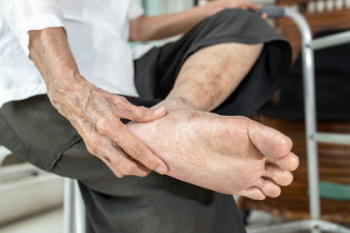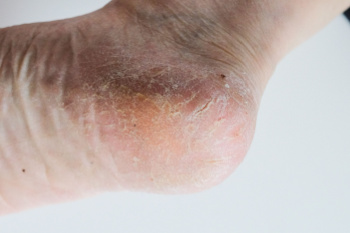Connect With Us
Blog
Items filtered by date: October 2024
Types of Broken Ankles

Ankle fractures can vary based on the location and severity of the injury. Common types of broken ankles include lateral malleolus fractures, which affect the fibula on the outer side of the ankle, and medial malleolus fractures, affecting the tibia on the inner side. Some patients may experience both, leading to bimalleolar fractures. Trimalleolar fractures involve three areas, which are the lateral, medial, and posterior malleoli. Pilon fractures, also known as plafond fractures, occur at the lower part of the tibia. Ankle fractures usually result from a high-energy impact, such as falls or car accidents, and often involve damage to both the bone and surrounding joint surfaces. Maisonneuve fractures involve both an ankle sprain and a break higher up the fibula. A podiatrist can assess the type of fracture through imaging tests and provide treatment options, which may include immobilization or surgery. If you believe you have broken your ankle, it is suggested that you make an emergency appointment with a podiatrist for an exam and diagnosis.
Broken ankles need immediate treatment. If you are seeking treatment, contact one of our podiatrists from Foot & Ankle Associates of Maine. Our doctors can provide the care you need to keep you pain-free and on your feet.
Broken Ankles
A broken ankle is experienced when a person fractures their tibia or fibula in the lower leg and ankle area. Both of these bones are attached at the bottom of the leg and combine to form what we know to be our ankle.
When a physician is referring to a break of the ankle, he or she is usually referring to a break in the area where the tibia and fibula are joined to create our ankle joint. Ankles are more prone to fractures because the ankle is an area that suffers a lot of pressure and stress. There are some obvious signs when a person experiences a fractured ankle, and the following symptoms may be present.
Symptoms of a Fractured Ankle
- Excessive pain when the area is touched or when any pressure is placed on the ankle
- Swelling around the area
- Bruising of the area
- Area appears to be deformed
If you suspect an ankle fracture, it is recommended to seek treatment as soon as possible. The sooner you have your podiatrist diagnose the fracture, the quicker you’ll be on the way towards recovery.
If you have any questions, please feel free to contact our office located in Brunswick, ME . We offer the newest diagnostic and treatment technologies for all your foot care needs.
Foot Ulcers and Infections in Elderly Diabetic Patients

Foot ulcers and infections are serious concerns for seniors with diabetes, especially those with neuropathy. Diabetic neuropathy reduces sensation in the feet, making it harder to notice injuries like cuts, blisters, or ulcers. These unnoticed injuries can quickly worsen, leading to infections. Poor circulation in individuals with diabetes further slows the healing process, increasing the risk of ulcers becoming severe. Infections that result from ulcers can escalate, potentially leading to complications, such as gangrene, which may require amputation, if not treated promptly. Regular foot checks, proper hygiene, and early intervention are essential in preventing and managing foot ulcers. If you are elderly and have diabetes, or are caring for an older person with diabetes, it is suggested that you schedule an appointment with a podiatrist to set up routine visits for foot exams.
Diabetic foot care is important in preventing foot ailments such as ulcers. If you are suffering from diabetes or have any other concerns about your feet, contact one of our podiatrists from Foot & Ankle Associates of Maine. Our doctors can provide the care you need to keep you pain-free and on your feet.
Diabetic Foot Care
Diabetes affects millions of people every year. The condition can damage blood vessels in many parts of the body, especially the feet. Because of this, taking care of your feet is essential if you have diabetes, and having a podiatrist help monitor your foot health is highly recommended.
The Importance of Caring for Your Feet
- Routinely inspect your feet for bruises or sores.
- Wear socks that fit your feet comfortably.
- Wear comfortable shoes that provide adequate support.
Patients with diabetes should have their doctor monitor their blood levels, as blood sugar levels play such a huge role in diabetic care. Monitoring these levels on a regular basis is highly advised.
It is always best to inform your healthcare professional of any concerns you may have regarding your feet, especially for diabetic patients. Early treatment and routine foot examinations are keys to maintaining proper health, especially because severe complications can arise if proper treatment is not applied.
If you have any questions please feel free to contact our office located in Brunswick, ME . We offer the newest diagnostic and treatment technologies for all your foot and ankle needs.
Common Foot and Ankle Conditions

Musculoskeletal conditions of the foot and ankle encompass a range of disorders affecting bones, muscles, ligaments, and tendons in this area. These conditions include plantar fasciitis, Achilles tendonitis, sprains, fractures, and arthritis. They often result from overuse, injury, or degenerative changes due to aging. Wearing poor footwear, abnormal gait, or underlying conditions like obesity can also contribute to the development of these issues. Treatment for foot and ankle conditions depends on the severity and cause. It may include rest or custom orthotics to correct alignment and reduce strain. In more severe cases, surgical intervention may be necessary to repair damaged tissues. Podiatrists are specialists in diagnosing and managing these conditions. Through personalized treatment plans, these types of doctors can help patients relieve pain, restore function, and prevent recurrence, promoting overall foot and ankle health. If you are having foot or ankle pain, it is suggested that you schedule an appointment with a podiatrist for a proper diagnosis and treatment.
Foot and ankle trauma is common among athletes and the elderly. If you have concerns that you may have experienced trauma to the foot and ankle, consult with one of our podiatrists from Foot & Ankle Associates of Maine. Our doctors will assess your condition and provide you with quality foot and ankle treatment.
Foot and ankle trauma cover a range of injuries all over the foot; common injuries include:
- Broken bones
- Muscle strains
- Injuries to the tendons and ligaments
- Stress fractures
Symptoms
Symptoms of foot and ankle injuries vary depending on the injury, but more common ones include:
- Bruising
- Inflammation/ Swelling
- Pain
Diagnosis
To properly diagnose the exact type of injury, podiatrists will conduct a number of different tests. Some of these include sensation and visual tests, X-rays, and MRIs. Medical and family histories will also be taken into account.
Treatment
Once the injury has been diagnosed, the podiatrist can than offer the best treatment options for you. In less severe cases, rest and keeping pressure off the foot may be all that’s necessary. Orthotics, such as a specially made shoes, or immobilization devices, like splints or casts, may be deemed necessary. Finally, if the injury is severe enough, surgery may be necessary.
If you have any questions, please feel free to contact our office located in Brunswick, ME . We offer the newest diagnostic and treatment technologies for all your foot care needs.
Are Bunions Affecting Your Everyday Life?
Causes and Relief for Cracked Heels

Cracked heels, or heel fissures, are a common foot problem where the skin on the heels becomes dry, thickened, and splits. These cracks can cause discomfort and pain, especially while standing or walking, and they can sometimes lead to infection if left untreated. Heel fissures occur when the skin loses moisture, leading to dryness and reduced elasticity. Contributing factors include prolonged standing, wearing open-backed shoes, obesity, and conditions like diabetes or eczema, which can cause dryness. Relief involves moisturizing the feet regularly with thick emollients or foot creams containing urea or lactic acid to soften the skin. In more severe cases, medical treatment may be necessary, such as debridement or the application of special wound dressings. If you have severely cracked heels, it is suggested that you schedule an appointment with a podiatrist for an examination and treatment.
If the skin on your feet starts to crack, you may want to see a podiatrist to find treatment. If you have any concerns, contact one of our podiatrists from Foot & Ankle Associates of Maine. Our doctors can provide the care you need to keep you pain-free and on your feet.
Cracked Heels
It is important to moisturize your cracked heels in order to prevent pain, bleeding, and infection. The reason cracked heels form is because the skin on the foot is too dry to support the immense pressure placed on them. When the foot expands, the dry skin on the foot begins to split.
Ways to Help Heal Them
- Invest in a good foot cream
- Try Using Petroleum Jelly
- Ease up on Soaps
- Drink Plenty of Water
Ways to Prevent Cracked Heels
- Moisturize After Showering
- Skip a Shower
- Keep Shower Water Lukewarm
- Don’t Scrub Your Feet
If you are unsure how to proceed in treating cracked heels, seek guidance from a podiatrist. Your doctor will help you with any questions or information you may need.
If you have any questions, please feel free to contact our office located in Brunswick, ME . We offer the newest diagnostic and treatment technologies for all your foot care needs.
Definition and Causes of a Bunion

Bunions are bony protrusions that form at the base of the big toe, often causing the tip of the toe to angle toward the other toes. Symptoms typically include pain, swelling, and redness around the joint, which may worsen with prolonged standing or walking. Bunions often develop due to genetic factors, improper footwear, or abnormal foot mechanics. Wearing tight or high-heeled shoes can worsen the condition by putting pressure on the toe joint. Diagnosing bunions usually involves a physical examination and may include X-rays to assess the extent of bone displacement and joint damage. For severe cases, surgical options may be considered to correct the deformity and alleviate pain. If you have symptoms of a bunion, it is suggested that you schedule an appointment with a podiatrist who can suggest treatment methods that are right for you.
If you are suffering from bunions, contact one of our podiatrists of Foot & Ankle Associates of Maine. Our doctors can provide the care you need to keep you pain-free and on your feet.
What Is a Bunion?
A bunion is formed of swollen tissue or an enlargement of boney growth, usually located at the base joint of the toe that connects to the foot. The swelling occurs due to the bones in the big toe shifting inward, which impacts the other toes of the foot. This causes the area around the base of the big toe to become inflamed and painful.
Why Do Bunions Form?
Genetics – Susceptibility to bunions are often hereditary
Stress on the feet – Poorly fitted and uncomfortable footwear that places stress on feet, such as heels, can worsen existing bunions
How Are Bunions Diagnosed?
Doctors often perform two tests – blood tests and x-rays – when trying to diagnose bunions, especially in the early stages of development. Blood tests help determine if the foot pain is being caused by something else, such as arthritis, while x-rays provide a clear picture of your bone structure to your doctor.
How Are Bunions Treated?
- Refrain from wearing heels or similar shoes that cause discomfort
- Select wider shoes that can provide more comfort and reduce pain
- Anti-inflammatory and pain management drugs
- Orthotics or foot inserts
- Surgery
If you have any questions, please feel free to contact our office located in Brunswick, ME . We offer the newest diagnostic and treatment technologies for all your foot care needs.

